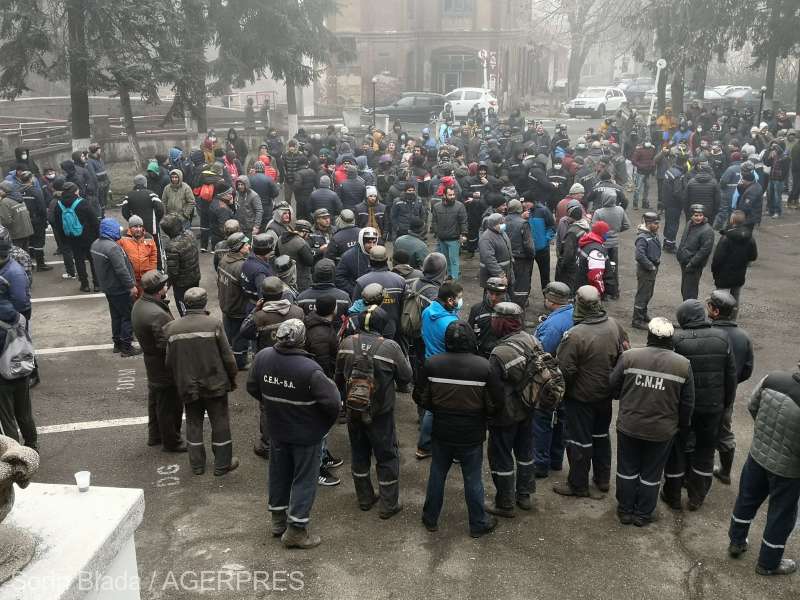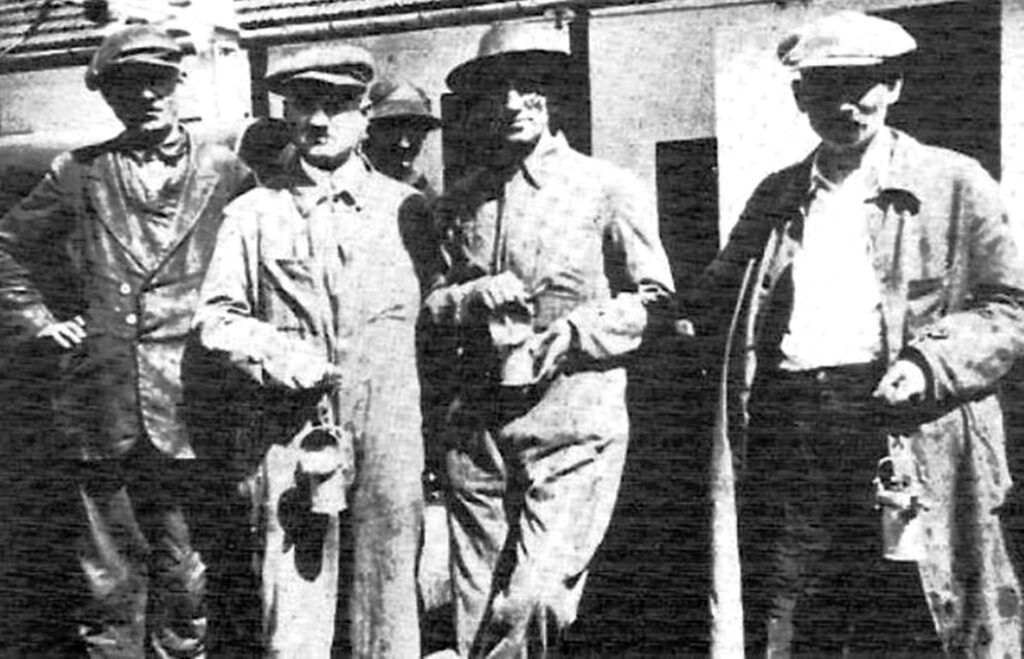On February 15, 2021, over 100 miners in Lupeni mine in Valea Jiului (Jiu Valley) – a mine that is still functioning but that is earmarked for closure following negotiation with the European Union – refused to come out when their shift ended and declared a strike. In the following days, hundreds of miners in the region protested in solidarity. The immediate reason for the strike is clear. The company that hires the miners (Hunedoara Energy Complex) is bankrupt and hence was unable to pay their salaries and bonuses for some months. However, the situation is much more dramatic than that and the causes are systemic. Chief among them is de-carbonization and the social costs of moving away from fossil fuel. While the miners are sure victims, their protest was quickly politically instrumentalized in both old and novel ways – to which I will return below.

Source: Agerpress
The Jiu Valley has been the most important coal-extracting region in Romania and key for its modernizing and industrializing efforts throughout the 20th century. Socialist modernization expanded the area exponentially and after the second oil crisis in 1979 coal was expected to completely replace oil in the local production of energy in order to lower costs. Hence by 1989, when the regime collapsed, in the Valley around 70,000 miners extracted approximately 12 million tons of coal per year. High intensity levels of labor exploitation, coupled with below par levels of work conditions and compensations, led to frequent negotiations and clashes between the government and the workers, culminating in the 1977 strikes, the most significant labor action under Romanian socialism. The political militancy of the miners was well known historically. In 1929, a strike in the Lupeni mine against harsh working conditions and austerity was brutally repressed by the government when the army killed 68 miners – one of the bloodiest labor militancy episodes in the interwar period.
The situation of the miners quickly deteriorated after 1989, when the political economy dramatically changed. Coal was deemed too costly, too polluting, and too inefficient to make economic sense, especially for a state in retreat. Forced to leave the area as mines began to shut down, the miners could not sell their houses for lack of buyers, and they simply abandoned them. Some of the state’s assets were privatized, others were simply closed and left to ruin, exacerbating the spiral of decline. Those who stayed in the area were unable to sustain the cost of urban infrastructure. One of the key processes in the area was the disconnection of flats and houses from the central heating system. With few customers and huge levels of unpaid bills, the local electrical power-plants scaled down their activities, which meant reducing the amount of coal they bought from the still-existing mines. By disconnecting from the grid, the miners were in effect further reducing their job prospects. Hence, the entire area switched from coal to timber for heating, precisely the inversion of the transition that the socialist urbanization of the area had implemented earlier on. Therefore, decarbonization in the area entailed not only de-urbanization but also the formation of a hybrid type of living environment in which some traditional urban features (such as blocks of flats, roads with traffic lights, the existence of a university, etc.) coexist with forms of rural living and economic relations.
The political decision to close down the mines was made in the early years of the first post-communist government. However, politicians had to compromise with the miners when faced with their labor militancy. Organized groups of miners descended on Bucharest on several occasions in the early 1990s, significantly altering the political life of the capital; these events are known as Mineriade in Romanian. From symbols of labor unity, the miners became figures of socialist working-class brutality. Like the rest of the socialist remnants, they also had to go. And they did. By 1997, about half of the miners were laid off after receiving between 12 and 20 salaries as compensation. Since then, around 1,000 miners are laid off every year. Romania’s EU ascension sped up the process; therefore, only four mines exist today out of 15 in 1990. By 2024, these mines are also expected to close in accordance with EU requirements, and the remaining 4,000 miners will be laid off. The miners in Lupeni know this very well; they just hope to get their remaining salaries on time until then – a fact that seems unlikely. The company that hires them is bankrupt and in mounting levels of debt. Mismanagement, embezzlement, and objective economic constraints all played their part, but is irrelevant now. Sooner or later, the company will close down and with it the activity of mining as such.

Source: Photo #DA083 – Fototeca online a comunismului românesc (ANIC, fond ISISP, Valea Jiului, 48/1944)
The closure of the mines resulted in the social devastation of the area alongside the already ecological one, after more than a century and a half of mining. Unemployment levels spiked, life expectancy rates dropped, just as the number of cases of alcoholism, domestic violence, and homicides shot up. Lacking the previous solidarities formed around labor and a shared sense of belonging and pride, the miners were unable to fight back collectively, except for some isolated cases of bargaining. Deprived of voice, many chose exit. Migration became the only available option for many, either as cheap migrant laborers to the west, or as agricultural workers in their home villages, or sometimes both. Gender and family relations were severely altered in the process. While the decarbonization process brought women, traditionally confined to the household in the miners’ universe, into the workforce, and thus offered them a renewed sense of agency. However, they became casual laborers in regional and continental networks of precarious and poorly paid work. For many women, industrial domesticity was replaced by agricultural domesticity and a completely different type of housework and care.
It is estimated that about half of the population of the Jiu Valley left in the three decades after 1989. Those who stayed faced specific and unforeseen challenges. Miners’ solidarity gave way to a clear distinction between those who readily accepted the compensation from the state and those who did not and remained to work as miners until the end, despite adverse conditions. This moral conflict further altered the social fabric and led to the destruction of the previously existing networks of trust and comradeship, thus furthering the moral, social, and urban decay unfolding in the area. Furthermore, the closing of the mines was not an even process in terms of consequences. While for many, especially miners, it meant immiseration and social dislocation, for a select segment it brought in handsome profits. One way to achieve this was to become the sole provider of materials the mines needed in their daily activities; the other was to act as intermediary between the mines, their clients, and the state. This led to an increased internal differentiation and class conflict inside the Jiu Valley itself, which underscores the uneven and highly contextual consequences of decarbonization in the area.

Source: Elena Dumitriu, L’emigrazione intellettuale dall’Europa centro-orientale. Il caso di Panait Istrati, Nuova Cultura, 2012, https://commons.wikimedia.org/w/index.php?curid=24716913
Coping mechanisms for those who stayed in the region were diverse, but generally combined small-scale entrepreneurship (like mini-markets and bars) with informal labor, such as illegal timbering for men and mushroom picking for women. Decarbonization entailed not only deskilling but also de-urbanization and a return to village-like economy. State efforts to mitigate the impact of decarbonization were ill conceived, poorly implemented, and marred by corruption scandals. The mining industry entailed not only extraction per se, but also a host of other institutions orbiting it and helping with its reproduction, such as kindergartens, hospitals, houses of culture, cinemas, and mountain cabins. They were either abandoned or privatized as the mines were closed down and the miners began to. The state and NGOs envisaged tourism as a solution for regenerating the area and for reallocating labor, but the investment was paltry compared to the funds required. Employees of the state institutions in the area, including a university that in the past educated future mining engineers – a specialization now redundant – constitute an important segment of the population that dispose of constant income and thus can sustain the modicum of economic life from further collapse.
This is the wider historical and social context in which the most recent protests in the Valley (as the region is fondly called by locals) must be understood. It is a rearguard struggle for survival. However, its significance lies elsewhere. Enter the political entrepreneurs. The current Prime-Minister Florin Câțu, a self-proclaimed Thatcherite that is currently pursuing an austerity agenda for public workers, reacted to the miners’ protests by stressing that during his mandate he will now allow another Mineriada. Surely, there was not even the slimmest chance of that. His message was intended to mobilize the old anticommunist trope of the brutish miners keen to descend on the capital and run havoc. It was part of the well-known arsenal of the old right-wing for demonizing and de-humanizing the miners as a violent, retrograde social category that does not deserve help or solidarity. His speech had the desired performative effect, since many social media users rushed to condemn the miners in vitriolic terms, as writer Vasile Ernu noted in his op-eds on the issue in a local newspaper.
Unavoidably, the old prejudices against the miners were also couched in green concerns, pointing to the climate cost of extracting and burning coal. This conflict is well known in other areas experiencing decarbonization and it already played out locally during the protests to Save Roşia Montană in 2013, when the economic wellbeing of the gold miners was opposed to the environmental concerns. Finding a right balance between the two is, naturally, not an easy task anywhere, and this type of conflict will escalate further when decarbonization policies (mostly related to oil and gas) will accelerate in the near future. It will be interesting to know, for example, how the urban and more educated oilmen and women will react when faced with the decarbonization of their industry.
Meanwhile, it is important to note how the latest protest in Lupeni occasioned the emergence of a different type of populism in Romanian politics. Diana Șoșoacă, an independent senator, was the only high-profile politician to visit the miners and rally to their cause. Șoșoacă, who entered the Parliament recently with the extreme-right party AUR (Alliance for the Union of Romanians) but was expelled following an argument with the leadership, has been a very vocal critic of the lockdown measures and of the legal imposition of mandatory masks in public. Her “in your face” and confrontational style made her a darling of televisions and her popularity soared. Her solidarity with the miners is part of a carefully calculated political ascendancy. But when addressing the miners, she set the basis for a very coherent populism that denies climate change and pins the blame for the closure of mines on local politicians subservient to the EU and other nefarious foreign interests. Șoșoacă is the first public politician since the 1990s who took the side of the miners and refused to see the closure of the mines as a fait accompli. As it is the case with right-wing populism, this is another example of a false friend that promises to save workers by way of cheap tricks. Vague echoes of Trumpism could be heard in her 10-minute-long speech. While for the miners the historical dices are rolled, their unwilling political instrumentalization might lead to a new form of populism, 30 years after their ideological construction as toxic remnants of communism. Therefore, the miners continue to remain important subjects of political dispute, while their immiseration deepens and their social standing worsens.
Note from LeftEast editors: this article is published in cooperation with the Eastern-European regional portal Bilten.

Florin Poenaru is an anthropologist and co-editor of CriticAtac. He works on issues of class and post-communism.
